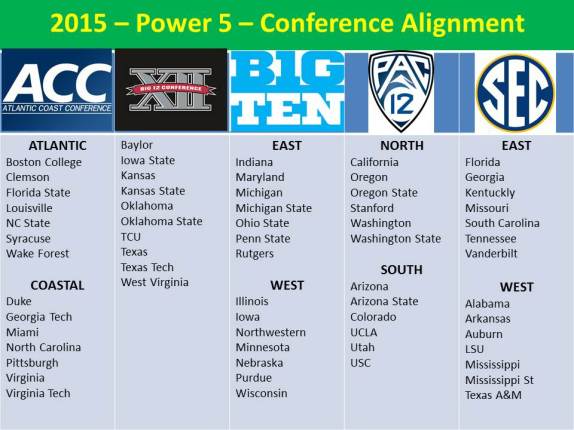So, here it is, February 12; Week 1 of the 2015 College Football Season is still over 6 months away, and, I wonder, is it too early to start looking forward to the Week 1 schedule? … HELL, NO!
Besides, what else do good, respectable, young college football fans have to do? Well, I might not be good, respectable or young, but I am a college football fan, so, here goes – the look ahead to Week 1.
The 2015 FBS College Football Schedule kicks off on a Thursday Night, September 3, with a couple intriguing match-ups.
The Carolinas, North and South will tangle at a, somewhat, neutral site, Bank of America Stadium, in Charlotte, NC, to get things started. Both teams are trying to get back into the thick of things in their respective conferences and this game should be a good indication of which team is poised to make a move. Steve Spurrier will be debuting a new signal caller in this game and the Tar Heel defense is a tough first-game assignment. The Tar Heels are currently ranked #35 in the ESPN PreSeason FPI Rankings and the Gamecocks weigh in at #40.
Jim Harbaugh will debut as the Head Coach for Michigan in Utah as the Wolverines try to pay back the Utes for embarrassing them in the Big House in 2014. A pretty tough assignment, to go on the road for your first game with a new program, and Wolverine expectations will be through the roof, but the Utes will be in no mode to be gracious hosts. An interesting match-up, indeed. Michigan currently stands at #28 in the ESPN PreSeason FPI Rankings while the Utes hold down the 38th spot.
After a nice double-dose of intriguing games on an opening Thursday night, football fans will get a couple of days rest to prepare themselves for the first Saturday of the new season and a handful of additional games that will merit some attention.
After leaving the program in 2013, Chris Petersen will head back to Boise State with his new team, the Washington Huskies. The Broncos will be anxious to show that his old, non-Power 5 program is still better than his new, PAC-12 squad. There will be a new gunslinger for the Broncos tossing footballs on the blue turf, but Boise State returns a good team coming off of their Fiesta Bowl victory over another PAC-12 team in #10 Arizona. Boise State is likely to be ranked in the Top 25 and Washington is likely to be one of those, “also receiving votes” teams coming into the game. Both teams will enter with a chip on their shoulder and one team will have it knocked off. Boise State is currently ranked #31 in the ESPN PreSeason FPI Rankings and Washington sits at #46.
The first Saturday also has Virginia travelling coast to coast to complete the home and home series against UCLA. The Cavaliers played a close, but losing game against the Briuns in their Virginia home in 2014. Going out west, however, the Cavaliers will be facing a Briuns’ squad that has a new QB at the helm, replacing the early departed Brett Hundley. It’s not easy going coast to coast for your first game of the season, as UCLA discovered last year; it will be interesting to see how this game kicks off the 2015 season for both teams. UCLA is currently ranked #12 in the ESPN PreSeason FPI Rankings while Virginia is ranked #56.
In what might be dubbed the Brainiac Bowl, the B1G Ten’s academic leader, Northwestern will make a trip out west to meet the PAC-12’s academic leader, Stanford. The Cardinal is likely to be a heavy favorite in this game, but an interesting matchup nonetheless between two of the finer educational institutions that happen to also field pretty good football teams. Stanford sits at #17 in the ESPN PreSeason FPI Rankings and Northwestern is down at #68.
The Badgers of Wisconsin are proving that they like to start off their seasons with a bang and do not shy away from tough scheduling challenges. Last year the Badgers started things off in a high-profile game against LSU, blowing a big lead in eventually losing the game, and will start off the 2015 season back in SEC country against the reigning SEC Champs in Alabama. The Crimson Tide does turnover a large portion of their starting lineup, but this seems to be something that Alabama does well. A good test for both teams to start the new year and a game that is sure to get most of the first Week spotlight going into the season. Alabama is currently ranked #2 in the ESPN PreSeason FPI Rankings and the Badgers fall in at #36. But, preseason polls are likely to have both teams in the Top 25.
In another intriguing contest with an SEC powerhouse, Louisville squares off against Auburn in the Georgia Dome. The Tigers will be replacing Nick Marshall at QB while Louisville brings in an experienced Will Gardner. Another early season measuring stick for two programs poised to make a run at their respective conference championships. Auburn is currently ranked #18 in the ESPN PreSeason FPI Rankings and the Cardinals sit at #44.
In a contest between two of the better teams in two of the best conferences, Arizona State and Texas A&M match up in NRG Stadium in Houston. This is another good match-up that could be an early indication of which team is ready to vie for a top spot in their respective conferences. Texas A&M is currently ranked #11 in the ESPN PreSeason FPI Rankings and Arizona State is a respectable #20. All in all, a pretty good Week 1 for the SEC West top teams to send a signal to the rest of the college football world that they are still the cream of the crop.
And, the first week of the season is capped off with a Monday Night affair between the Buckeyes of Ohio State and the Virginia Tech Hokies. Last year, the Hokies hung an albatross around the Buckeyes’ necks almost big enough to keep them out of the playoffs. Ohio State overcame that “bad” loss on their journey to the National Championship, but will be looking to avenge the loss in Blacksburg. One thing for sure is – whichever QB is under center for the Buckeyes this time, it will be one with a lot more experience than JT Barrett had going into last years’ game. Ohio State currently sits atop of the ESPN PreSeason FPI Rankings at #1 while Virginia Tech is ranked #25.
So, yes, it is over half a year away, but the intrigue these games promise will only grow brighter and brighter as the season gets closer and closer. There will also be some interest in games that appear less fairly matched as the nation watches to see how new QBs perform under center – like the Eastern Washington vs Oregon game in which Oregon’s new QB just might be Eastern’s old QB; and, the Texas State vs Florida State game in which famous Jameis will likely be watching from an NFL camp somewhere.
For now, however, its nearing time for college football fans to go into their summer hibernation, dreaming of the sounds of whistles to ring in an interesting Week 1.








 Meanwhile, in 1890, at the University of Michigan, a young black man by the name of
Meanwhile, in 1890, at the University of Michigan, a young black man by the name of 

 men shared in common at their respective universities, helping solidify an already heated rivalry, is known as the Ten Years War. The drama played out between these two coaches and these two teams during that time is legendary. Teacher and student, squaring off against each other in a season ending game that usually would determine the Conference Champion, a trip to the Rose Bowl, and, in some cases, the National Championship.
men shared in common at their respective universities, helping solidify an already heated rivalry, is known as the Ten Years War. The drama played out between these two coaches and these two teams during that time is legendary. Teacher and student, squaring off against each other in a season ending game that usually would determine the Conference Champion, a trip to the Rose Bowl, and, in some cases, the National Championship.
 It seems every one of Michigan’s coaching hires since Bo’s retirement has been met with a tinge of controversy sprinkled with lots of high expectations only to end in disappointment – although Lloyd Carr had a pretty good, 12-year run at the helm. The two most recent regimes, however, have been nothing short of catastrophic. So, in rides Jim Harbaugh on a horse of high expectations, with the moxy and pedigree to pump hope back into the hearts of all good Wolverines. And, one might wonder, do we have the potential of the next version of Woody and Bo on our hands?
It seems every one of Michigan’s coaching hires since Bo’s retirement has been met with a tinge of controversy sprinkled with lots of high expectations only to end in disappointment – although Lloyd Carr had a pretty good, 12-year run at the helm. The two most recent regimes, however, have been nothing short of catastrophic. So, in rides Jim Harbaugh on a horse of high expectations, with the moxy and pedigree to pump hope back into the hearts of all good Wolverines. And, one might wonder, do we have the potential of the next version of Woody and Bo on our hands?